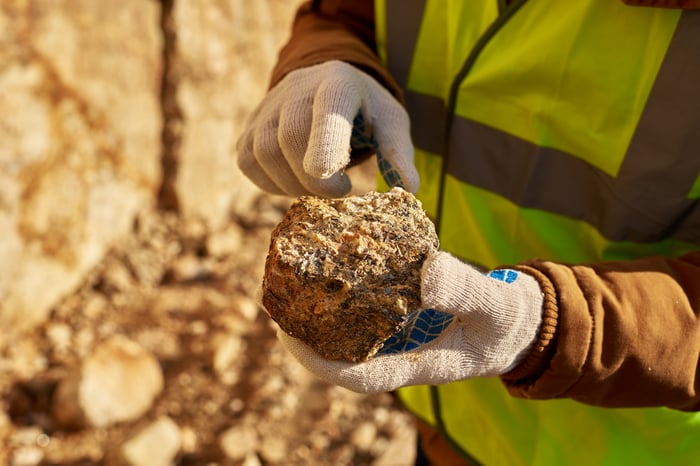There are many different ways to get exposure to gold, from hoarding gold coins to buying a gold miner. Each comes with different risk and reward dynamics, with miners generally tied to the price moves of the precious metals they mine. Smaller miners, meanwhile, tend to move more than larger ones relative to gold and silver. Here's what that means, and why it happens.
Gold is just gold
Gold and silver are physical assets, which is pretty simple to understand. However, that carries big implications for investors. For example, precious metals don't offer growth potential over and above the changes in their values, since an ounce of gold will always be just an ounce of gold. A miner, however, is a business that can expand over time. It can produce more gold by investing in its mining operations. This is one of the reasons why many investors prefer miners over physical gold.

Image source: Getty Images
However, there's another important aspect to keep in mind here. Gold miners have to use money to build, run, and maintain mines. That's not a small issue, since mining is a very expensive business. If the spot price of gold is below the money it costs to mine for the metal, a miner will lose money. On the flip side, if the spot price is above mining costs, the miner will make money.
One of the most common measures of mining costs is called all-in sustaining costs (AISC). AISC is basically a mixture of how much money a miner requires to operate its mines, plus the costs it pays to maintain its mines. That includes maintaining all of the company's equipment, but also the capital spending needed to maintain production over time by investing in mine development activities. There's another measure that investors will often see called cash cost, but that just looks at the money needed to mine. Cash costs don't consider upkeep costs, which can be material, so it doesn't provide as full a picture.
When you take AISC into consideration, you start to see why miners are tied to the price of gold.
What goes up...
Take, for example, industry giant Barrick Gold (GOLD 0.71%). The company's first-quarter all-in sustaining costs were about $950 an ounce, rounded down to the nearest $10 to simplify the math here. At the start of the year gold was trading hands at around $1,530 per ounce. Roughly speaking, Barrick was making $580 per ounce of gold at that price. Recently, though, gold has been trading near all-time highs in the area of $2,000 per ounce. Now Barrick is making roughly $1,050 per ounce. This is a simplification, since miners face other costs, too, but it gives you the general idea of what's going on.
But do the math on this. Gold increased in price by roughly 30%, but Barrick's profit per ounce increased by 80% or so. That's the leverage inherent in the mining business -- but there's more to the story. This math changes materially based on the miner you are looking at. Take, for example, Golden Star Resources (GSS), which is a tiny, $500-million-market-cap miner, compared to $50-billion-market-cap Barrick. Its AISC in the first quarter was roughly $1,200 per ounce. That's a big difference on the cost front.
Using the same gold prices as the example above, Golden Star was only making around $330 per ounce of gold it mined at the start of the year. With gold at $2,000, however, it's now making about $800 per ounce. That's an increase of 140%, much more impressive than the increase at Barrick. Larger miners usually benefit from economies of scale, and generally have lower costs than smaller miners. However, this difference helps explain why the shares of small miners often move more dramatically than the stocks of larger miners.
The problem with this math, and why investors need to tread carefully when buying miners today, is that the leverage works in reverse fashion as well. If, say, gold fell all the way back to the prices it fetched in the beginning of the year, Barrick's profit per ounce of gold would decline roughly 45%. Golden Star's profit would fall nearly 60%. In other words, a gold miner's leverage to the price of gold cuts in both directions.
Be careful
It's exciting to see stocks rocket higher, as has happened with many miners, particularly smaller ones with higher cost structures. However, gold has a long history of being a volatile commodity prone to swift and dramatic price swings. Before a long-term investor jumps aboard any miner's stock today, it pays to consider what might happen if gold prices fall. If you do that, you might end up deciding that you're better off with a gold investment that isn't quite so leveraged to the price of the precious metal.






